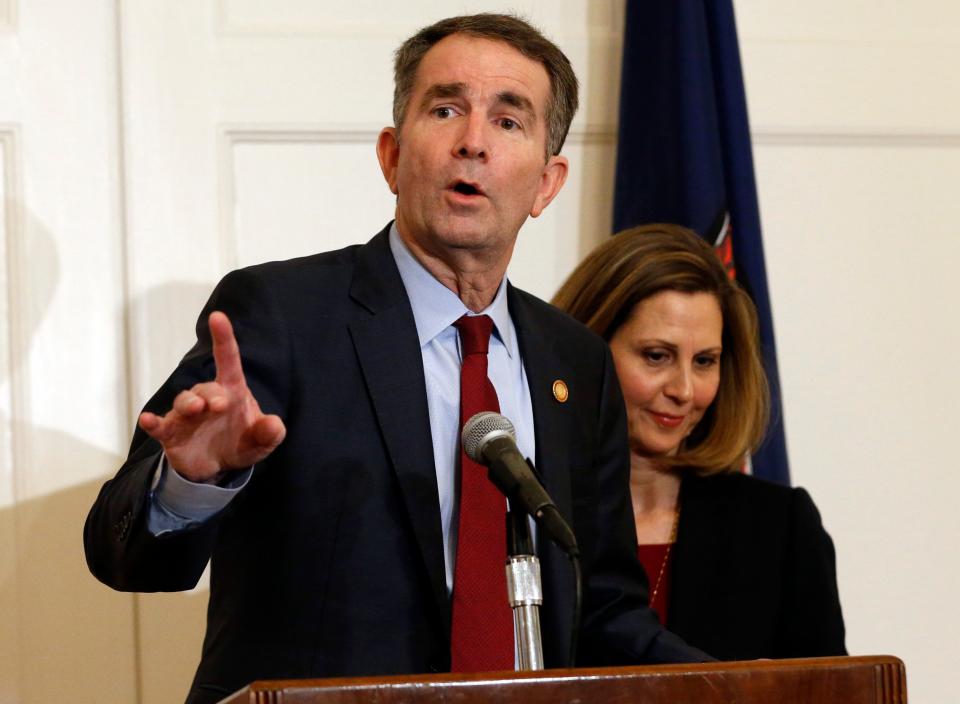NAACP president: Dehumanizing African-Americans with blackface has real consequences

Words and images have meaning. They have weight. And they have consequences.
In America, the most powerful and dangerous of these words and images were born in times of intense oppression and hatred. These racialized depictions and icons of speech litter our current political landscape in the form of seemingly innocuous rhetoric such as "build a wall" to yearbook photographs of figures in blackface.
Though Virginia Gov. Ralph Northam, and now Virginia Attorney General Mark Herring, are at the center of this latest controversy, the true problem does not begin or end with these two men. It did not begin or end with Michael Brown, Eric Garner, Sandra Bland, Philando Castile or the litany of other Black lives. It did not begin or end with the tacit endorsements of white supremacist violence from our nation’s highest office. None of these events caused the racially charged violence plaguing our country.
Instead, they are the consequence of our nation’s collective unwillingness to recognize that 400 years of dehumanizing language and imagery have a cultural impact that expresses itself through explicit and implicit bias.
One can reach back to imperialism, slavery, segregation or the Jim Crow era, but it is not necessary. Flashpoints exist as recent as President Ronald Reagan and his words in Neshoba County, Mississippi. His callback to "states' rights" — an assertion historically associated with the perpetuation of slavery — made in a former Confederate state with a close and continuing relationship with terrorism and lynching, was an ill-thought, inconsiderate choice of words at best and a calculated, intentional threat at worst.
More commentary: Virginia's blackface meltdown shows how slavery and tribalism still warp our politics
More from News: Ralph Northam was far from alone: Why blackface keeps coming up
This racialized imagery resurfaced in the late 1980s during George H.W. Bush's campaign against Massachusetts Gov. Michael Dukakis in an ad featuring an intentionally menacing portrait of Willie Horton. The image was to tap into the cultural fears that previous depictions had established within the public’s mind: that Black people are inhumane criminals.

President Bill Clinton fueled the fires of bias in the cultural collective with his 1994 crime bill. Ostensibly presented to keep communities safe from the “superpredator,” the bill, with its incentives for harsher punishments and its three-strikes mandatory sentencing, once again correlated criminal behavior with African-Americans. Clinton's words and actions built on previous "war on drugs" legislation, the already growing trend of mass incarceration and the criminalization of being born with black or brown skin.
'Tough on crime' targeted Blacks
The cold numbers bare this truth out. The 1980s' "Tough on Crime" era resulted in dramatic growth in incarceration. Of those incarcerated, African-Americans are sentenced to correctional facilities at more than five times the rate of whites. The "war on drugs" only enhanced the effect as, from years 1980 through 2007, African-Americans were arrested on drug charges at rates that were 2.8 to 5.5 times higher than whites.
As a result of the deliberate act to criminal people of color, by 2016, African-Americans represented only 12 percent of the U.S. adult population but accounted for 33 percent of the prison population, while whites accounted for 64 percent of the population but only 30 percent of its prisoners.
This criminalization phenomenon is not a partisan issue. The fact that Reagan's and Clinton’s words and Bush’s imagery encountered little resistance, and even less self-reflection, enabled others to act upon their racial bias with approval of the nation. It is today’s climate of acceptance for racialized words and images that empowered George Zimmerman to gun down Trayvon Martin with both impunity grounded in the repeated correlation of Blacks and criminality. The cultural consequences of racialized language and imagery have manifested as a zeitgeist that is devastating the African-American community and fueling the need for movements and organizations such as Black Lives Matter, Dream Defenders, BYP100 and United We Dream.
Obama election a bright light
That is not to say that there have not been some bright lights in this darkness. The election of the nation’s first African-American president, Barack Obama, was a significant step toward a truly inclusive democracy. Similarly, the FIRST STEP Act, too, will hopefully live up to its name and pave the way for more criminal justice reform.
This forward movement toward the promise America has always held is a welcomed and imminently laudable accomplishment, but it does not banish the shadows of racism and intolerance that lurk in this country’s corners. Indeed, their light makes these shadows darker by contrast.
The darkness implicit in uncontested racialized speech and images carries consequences that reach all people of color. Trump’s many statements and tweets calling a caravan of immigrants “stone cold criminals,” his policies separating immigrant families and placing children in detention centers, and his repeated calls to "build a wall" are all a continuation of America’s embrace of racialized words and images. It is a doubling down on the dehumanization of people of color in the media.
Words and images do not exist in a vacuum. They have power, and they can and have been used to threaten the livelihoods of communities of color.
Derrick Johnson is president and CEO of the NAACP. Follow him and the NAACP on Twitter at @DerrickNAACP and @NAACP.
You can read diverse opinions from our Board of Contributors and other writers on the Opinion front page, on Twitter @USATODAYOpinion and in our daily Opinion newsletter. To respond to a column, submit a comment to letters@usatoday.com.
Help us shed light on racism at colleges across the country: Do you remember an event at your alma mater that seems extra weird now? Found blackface pictures in your own yearbook? DM or email me at brett.murphy@usatoday.com
— Brett Murphy (@BrettMmurphy) February 8, 2019
This article originally appeared on USA TODAY: NAACP president: Dehumanizing African-Americans with blackface has real consequences

